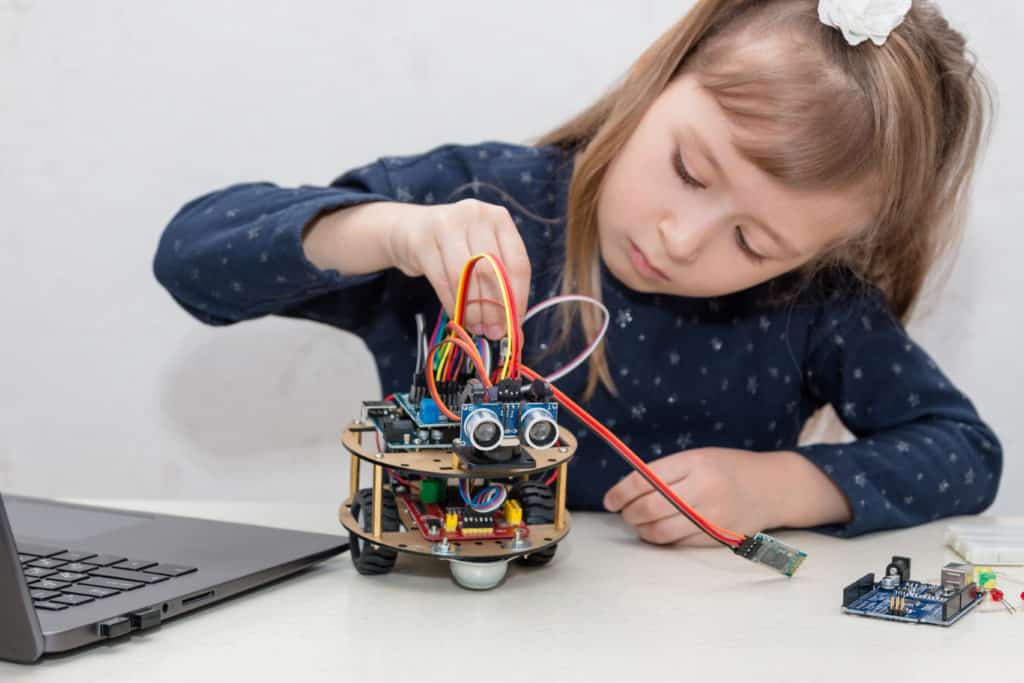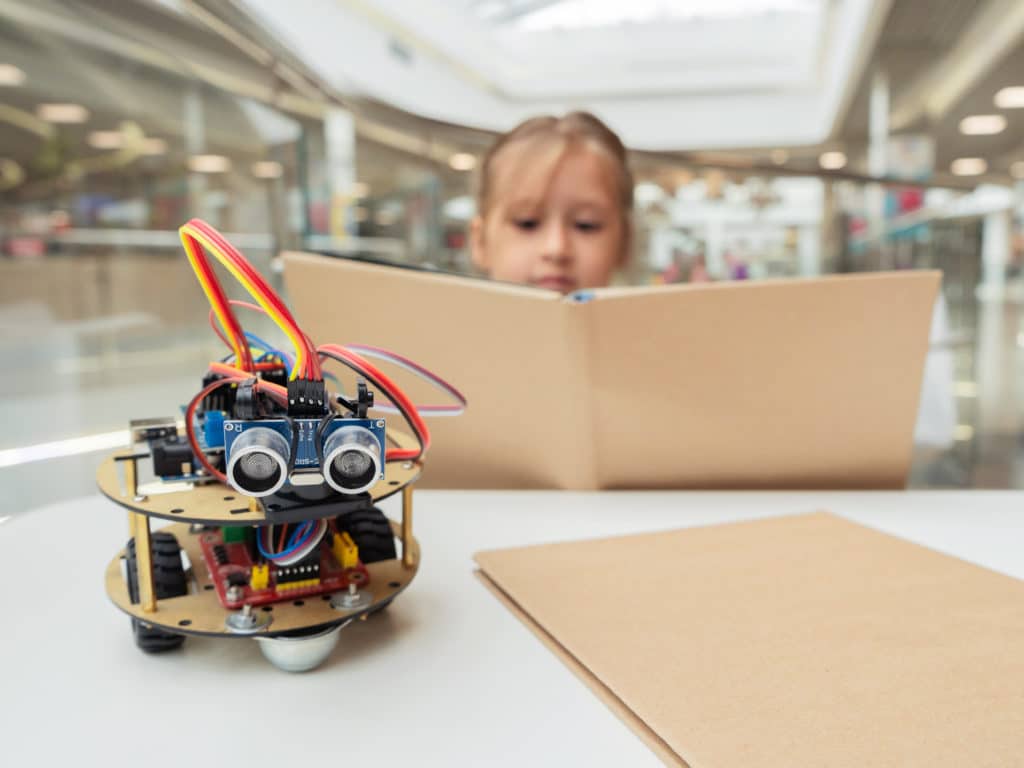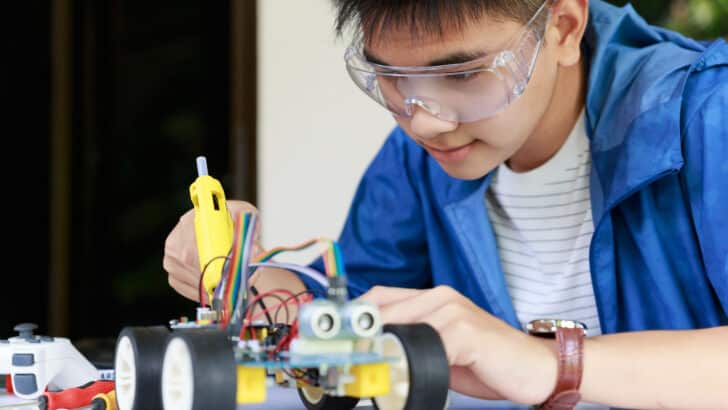Arduino is one of the easiest ways to get into computer programming and learn about electronics.
You should be able to pick it up within a few weeks or months. Better yet, there are dozens of ways that this technology can be put to good use.
So, what can I build with Arduino?
There is almost no limit to what you can create with an Arduino. Some of the most popular projects center on; automation, connecting to the Internet of Things, robotics, and creating wearable technology. There are dozens of sensors that you can connect, giving you hundreds of projects to explore.
What you can use the Arduino for is limited only by your imagination. Keep reading to get more insights into what Arduino can and can’t do.
How an Arduino Works
To understand why the Arduino can be used to make so many items, we first need to briefly understand what it is and how it works.
The Arduino is a very flexible and open-source way of making electronic items. There are 2 main elements to Arduino:
1) Hardware
There are several Ardunio boards that you can choose from, depending on what you want to make.
These boards are able to read various data inputs and turn it into an output. You connect any sensors or devices using electronic circuits.
For example, you may have a temperature sensor or a motion sensor that feeds data into your Arduino board, triggering an output – perhaps a digital thermometer display, or switching on an LED light.
2) Software
You can tell your Arduino board how to respond to the various input data, by programing a set of instructions using the Arduino IDE software and then uploading it to the microcontroller on the board.
Arduino programing language is based on C and C++, so if you know these already you’ll be able to pick up the process really easily.
Otherwise you can learn to program, hire someone to help you, or simply copy & paste the code from various online tutorials.
- Check out our article: How Easy Is It To Learn Arduino?
The type of projects you will be able to make will depend on the board that you are using.
For example, if you are planning on using a microphone, you will need to get a board that contains communication ports.
The good news is that, as the Arduino has grown more popular, the range of boards available has expanded.
This gives you more functionality to explore. Furthermore, the Arduino has spawned a global network of fans.
Because of this, you might be able to source specialized pieces of equipment, giving you even more options.
What Can I Build With Arduino?

With such a wide range of components and items to choose from, there are hundreds of things you can do with an Arduino.
To give you a better idea of what you can do with it, here are some of the most popular types of projects:
Automating a process
An Arduino is perfect for automating a process. You can set up sensors to detect when something needs to be done. As an example, you can use a motion detector to determine when someone is in the room. This can be a cue to turn on the lights.
Controlling items or conditions
You can use your Arduino to control your environment, even when you aren’t in the room. For example, you can set up a sensor to detect moisture (or lack of moisture). This can be the input needed to close the windows or turn on a water supply.
Wearable technology
You might be able to use the Arduino board to create cool wearable technology for yourself. This can be a great way to express yourself. For example, you might want to design a watch that is based on your favorite movie, or flashing lights embedded in clothes.
Internet of Things
You might want to use the Arduino to gather data about the world around you. This can give you more insight, allowing you to come up with innovative ways to switch household appliances on and off, for example.
Robotics
You can even use the Arduino to build a basic robot. You can program it to complete almost any action that you can imagine and to respond to a variety of different inputs for sensors or controls.
Let Your Imagination Run Wild
It should be noted that these uses are just general categories. There is a vast array of ways to customize the project to suit you.
For example, you might want to incorporate GPS, cameras, or connect it to the internet.
You might want to add a motor or a light. You can even connect it to a computer. You can also add a huge array of sensors.
These add-ons are easy to find; all it will take is a quick online search.
If you head into your local electronics store, you should be able to find plenty of parts. Some stores can even create specialized products, just to suit your project.
A quick Google search will reveal hundreds of projects that you can complete. Most of these will come with in-depth instructions.
- Check out this list of more than 400 Arduino project ideas.
If you are new to the world of Arduino, all you need to do is pick one and you can get started. Check out our range of tutorials for some ideas to get you started.

What Can You Not Do With Arduino?
There isn’t a lot that you can’t do with an Arduino. But that doesn’t always mean that it’s the best tool for the job.
For example, the Raspberry Pi is a common alternative. It is a bit more complicated to learn but offers more flexibility for interconnected devices.
For example, if you want to interface with a computer, like reading the content of a USB, it might be easier to use the Raspberry Pi.
Real-World Products
Furthermore, while the Arduino is great for hobbyists, it won’t be found in too many real-world products. There are a few reasons for this. These include:
- It can’t match the performance of other micro-controllers. As a result, products that are relying on Arduino will break down sooner. Often, they will need to be replaced after five years.
- There is no way of debugging the Arduino IDE. Furthermore, it doesn’t have the same libraries that other micro-controllers offer. This can be a challenge for developers, making it harder for them to get the actions they want.
- Open-source nature. One of the biggest reasons why this isn’t used in a lot of real-world products is because of its open-sourced nature. This would make it very difficult for companies to protect their intellectual property. If someone can figure out how it is working, and post the plans online, people will be able to replicate it themselves for a fraction of the price. As you can imagine, this causes headaches for the lawyers in most companies.
Industrial Products
It’s also unlikely that you will be able to use the Arduino as part of the manufacturing process. This is due to the durability of the boards.
They just aren’t suited to dealing with things like high heat, dust, and a lot of moisture. Faced with these conditions, the Arduino chip would only last for a few hours.
As a result, those in the manufacturing industry will need to turn to specialized boards.
Though these will be significantly more expensive than Arduinos, they are purpose-built to withstand harsh environmental conditions.
Benefits and Limitations of Using Arduino
While Arduino is very popular, it isn’t the only type of micro-controller on the market. You’ll need to find the right one for your project.
This table lists some of the benefits and limitations that come from using an Arduino:
| Benefits | Limitations |
| Cost. The Arduino is very inexpensive to buy. You’ll be able to get started for under $150. | Small size. The Arduino is known for being compact. This can sometimes make it difficult to solder the connections you require. |
| Huge Fanbase. The Arduino has a global community of dedicated users. As a result, there is plenty of support available. | Limited processing power. Compared to some of the other micro-controllers, the Arduino has a lower amount of processing power. Whether this is a big deal will depend on the type of projects you want to use it for. |
| Large free code library. There is plenty of code for you to use in your project. Often, you might just need to make a few tweaks, to get the output you want. | Lack of debugging tools. Sometimes, it can be difficult to get the code to work the way you want it to. Unfortunately, there is a lack of debugging tools, so it can be difficult to spot the problem. |
| Easy to program. The Arduino runs a variant of C++. As a result, you will find it easy to write programs for it. Or, you can adapt code that someone else has created. | |
| IDE runs on any computer. Unlike some other micro-controllers, the IDE for Arduino will be suitable for all types of computers. This makes it one of the most accessible micro-controllers ever. | |
| Easy to learn. Arduino comes with plenty of courses and resources. Because of this, someone starting from scratch should be able to learn the basics within a few months. This will be enough to allow you to take on dozens of projects. | |
| Open-source. Lastly, it is open-source. This ensures that you will be able to freely share your designs, or copy someone else’s. This has formed a sense of community online, with everyone open to helping each other improve their project design. |
While Arduino might not be the right fit for all projects, the pros outweigh the cons. Because of this, it’s probably the best place for a complete beginner to enter the world of computer programming.
Final Thoughts
The Arduino is inexpensive and easy to use. But don’t let that trick you into thinking it’s a child’s toy. There is a huge range of projects you can complete using Arduino.
Anything from building a watch and measuring the temperature to creating a functioning robot. The only real limit is your imagination and patience to learn.
Benne is professional Systems Engineer with a deep expertise in Arduino and a passion for DIY projects.

